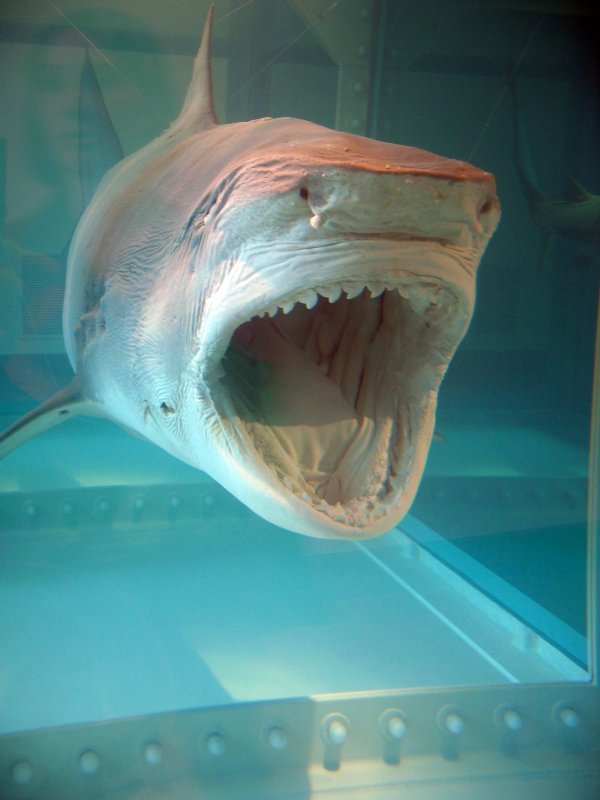Art Critics the Physical Impossibility of Death in the Mind of Someone Living
The heterogeneous artistic exercise of 1 of the best-selling artists on the entire world, Damien Hirst, is based on the historical examples of Duchamp'south readymade, early mail service-state of war assemblage and Conceptual Art of the 1970s. The artist'due south career came to prominence much faster than that of his peers from the Young British Artists generation, and and so he gained fame with controversial hybrid works dominated by the motifs such as dots, skulls, and formaldehyde animals.
The early work which ready the foundation for the upcoming success and critical acclaim for Hirst is The Physical Impossibility of Death in the Mind of Someone Living or colloquially known as The Shark made by the artist in 1991. Information technology is an bodily tiger shark preserved in formaldehyde in a vitrine, and this installation was commissioned by Charles Saatchi who was willing to pay for whatever artwork Hirst wanted to produce. The animal was caught by a commissioned fisherman in Hervey Bay in Queensland, and the artist's desire was to accept a specimen "big enough to consume you".

The Concrete Impossibility of Death In The Mind Of Someone Living
This Damien Hirst work was exhibited for the first time in 1992 equally role of the Young British Artists testify at the Saatchi Gallery, and then located in northward London. Alongside the shark, on display was also Hirst's artwork A Chiliad Years; the same yr the artist was nominated for the Turner Prize.
What makes this object so peculiar and staggering is the fact that the brute is depleted from its natural surrounding meaning that information technology is motionless, frozen and preserved. A big number of people have never seen a shark except on telly or at an aquarium, so the piece of work practically allows the audition to see it in a prophylactic surrounding, and potentially face their abstracted fears.
Namely, this artwork opens up the question of how we interact with nature and other species, and then the artist essentially becomes an intermediary of feel which makes this work operating on several levels – from a psychological perspective with man fears; from a zoological perspective with the features and characteristics of an brute; from the perspective of pop culture with the disturbing imagery; and finally from an artistic perspective with the broadening of the notion of an artwork.
Damien Hirst Shark - The Concrete Impossibility of Decease In The Mind Of Someone Living
The Preservation And The Cost of Damien Hirst Shark
Since the shark was initially not preserved well, it began deteriorating so the liquid inverse color. Hirst claimed that decay was acquired by bleach added by the Saatchi Gallery. The rooting original fourteen-foot tiger shark was replaced with a new specimen in 2006, and the process was supervised past a scientist and fish curator at London's Natural History Museum Oliver Crimmen. The brute was injected with formaldehyde, soaked for two weeks in a bath of 7% formalin solution, and was positioned in 1991 vitrine. On that occasion Hirst expressed his concerns whether the replacement of shark changes the work:
It's a big dilemma. Artists and conservators accept different opinions about what'southward of import: the original artwork or the original intention. I come from a conceptual art background, and then I think information technology should be the intention. It's the same piece. But the jury will be out for a long time to come.
Equally it was mentioned, the work was initially funded by Charles Saatchi; Hirst paid £half dozen,000 for the deputed shark while the total cost of the work was £50,000. In 2004, Saatchi sold it to Steven A. Cohen for an unrevealed amount, and the odds are that it was a sum of at least $8 one thousand thousand.

The Responses and Variants of Hirst's Sharks
In 2003 the Stuckism International Gallery displayed the shark which was displayed two years before Hirst'southward by Eddie Saunders in his London store. The artists gathered effectually this movement claimed that Hirst probably got the thought for his installation from the store display.
In 2004 while giving a lecture at the Royal Academy of Arts in London, the fine art critic Robert Hughes used The Concrete Impossibility of Death in the Mind of Someone Living as a solid proof that the international fine art market at the time was a cultural obscenity without specifically naming the work.
Despite the various critiques, in 2008 Hirst sold a variation of 1991 work titled The Kingdom at Sothebys auction for £nine.6 meg (more than £iii million above its estimate). The artist even produced a miniature version of The Physical Impossibility of Death in the Mind of Someone Living for the Miniature Museum in holland - a guppy fish is located in a box (10 × 3.five × 5 centimeters) filled with formaldehyde.
The Shark is undoubtedly saluted as one of the crucial works of British fine art in the 1990s and has become a symbol of Britart globally. In a menstruum between 2007 and 2010, it was on loan to the Metropolitan Museum of Fine art in New York City and was even featured in one of the scenes of the British-Hungarian film The Nutcracker from 2009.
Whether we might fence it is bad or good fine art, or whether is information technology art at all, looking from current perspective it is apparent that The Physical Impossibility of Death in the Listen of Someone Living changed the course of 20th century art and moved its boundaries posing significant questions of interspecies communication, marine heritage, and homo fears.

Editors' Tip: Damien Hirst: Void
Damien Hirst has continually challenged the boundaries between art, science, the media and popular civilisation. A 12-human foot tiger shark,a cow and her dogie sawn in two, pharmacy bottles, business firm pigment poured onto spinning canvases, cigarette butts, medicine cabinets, office furniture, medical instruments, butterflies and tropical fish, and, most recently, a diamond-encrusted skull are just some of the means Hirst employs to communicate his unflinching view of the ambiguity at the heart of human experience.
Featured image: Damien Hirst - The Physical Impossibility of Death in the Mind of Someone Living, 1990. Image via Flickr.
Source: https://www.widewalls.ch/magazine/damien-hirst-shark-the-physical-impossibility-of-death-in-the-mind-of-someone-living
0 Response to "Art Critics the Physical Impossibility of Death in the Mind of Someone Living"
Postar um comentário